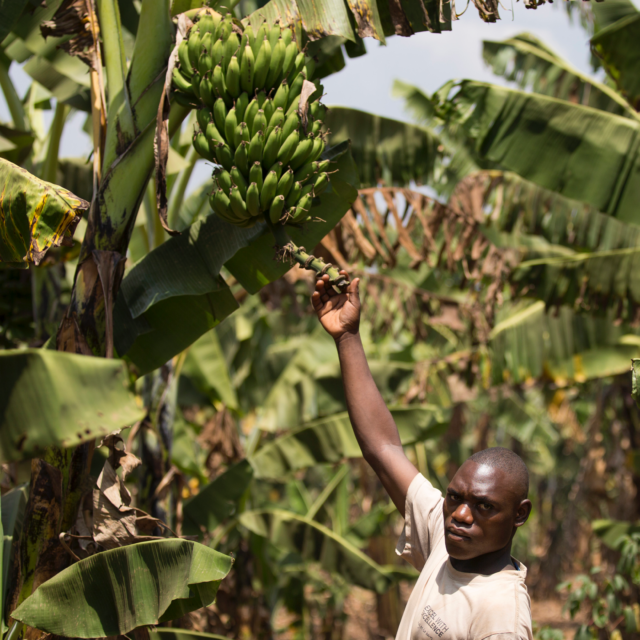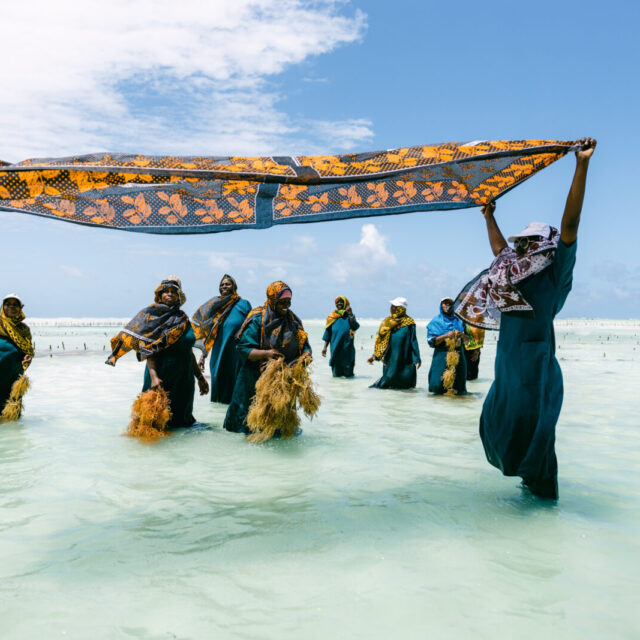Facts from our Africa COVID-19 Tracker
- Total population: 44,269,594
- Percentage of population living in extreme poverty: 41.5%
- Food inflation: -1.2% (latest: 30 January 2021)
- People with insufficient food intake: 34.1% (latest: 25 Feb 2021)
- Children (under 5) with chronic malnutrition: 28.9%
Economy
Uganda is a low-income country with a fast-growing population. 68% of the population work in the agriculture sector, 7% in industry, and 20% in services. Like many African nations, the future of the Ugandan economy is dependent on the global response to COVID-19. When the country closed its borders for four months, with exception of essential activities, everyday public life came to a halt. The closure of schools, restaurants, and shops and bans on public transport and social gatherings have caused massive job losses. The World Bank reported that even if the economy starts to recover in 2021, it will remain below its pre-COVID trajectory.
Uganda is the largest refugee host in Africa and third largest in the world. As of January 2021 , Uganda was hosting 1,446,378 refugees and asylum seekers, mostly from South Sudan and the DRC. The country has a progressive open-door refugee policy, allowing access to social services, land, and jobs to all refugees. The UNHCR has praised Uganda’s policies as some of the most progressive in the world. However, refugees are bearing the brunt of the economic downfall, as humanitarian support declines, along with Uganda’s economy. The continued and growing inflow of people into the country, combined with limited resources, is putting an enormous strain on the country’s resources.
Public health and food insecurity
According to the UN World Food Programme (WFP), malnutrition is widespread, with Ugandans consuming 400 fewer kcals daily in 2019 than needed. Food insecurity has risen during the pandemic, withmany households under immense strain to find food for their families. The outcome is that 28.5% of children are now suffering with chronic malnutrition. As of February 2021, 34.1% of people in the country have insufficient food intake.
The government distributed food packages of maize flour and beans to families in need of support. But many households in rural areas did not receive the food packages on the assumption that rural communities could produce their own supplies. A mere 12% of the population received food assistance. Rural areas have some of the highest rates of poverty in the country, but they received the least amount of support. A report by the Food Rights Alliance and Twaweza found that 24% of urban families receive support compared to 7% of rural households.
For the people seeking refuge in Uganda, food insecurity is at a crisis level. Due to a funding deficit, WFP cut the food rations of 1.26 million refugees in Uganda. In December 2020, WFP said that as of February 2021, refugees will only receive 60% of a full food ration. WFP Country Director El-Khidir Daloum said that the program is unable to sustain even basic aid, meaning that the poorest will undoubtedly suffer. Over the next six months, US$95.8 million is required to aid those seeking refuge in Uganda.
Women and children
The partial closure of schools in Uganda is affecting 10.6 million children, robbing them of the opportunities that a full education offers in life. Even before the pandemic, the stark reality in Uganda was that only 62% of children completed primary education, and because of underfunding, many children do not get a chance to attend primary school. One of the barriers to education is the hidden costs within the free system. The cost of purchasing uniforms, school supplies, and meals creates a barrier for those living in poverty.
Girls face multiple obstacles with education, as boys are often prioritised when families consider the cost of sending a child to school. Another barrier to education for girls is the 24% rate of teenage pregnancy, which are some of the highest in the world. Along with teen pregnancies, 40% of girls in Uganda drop out of school to get married before the age of 18, and once married, many will face violence in their home.
Women and girls shelter from the pandemic in their homes, the place that should be the safest location for them. However, at the beginning of the COVID-19 lockdown, a total of 3,280 cases of gender-based violence were reported to the Ugandan police. This is a significant surge from the concerning 1,141 monthly average of cases reported prior to the pandemic. UN Women has named the growing violence against women a “shadow pandemic,” as cases rise in Uganda and around the world.
COVID-19’s impact on women and children, refugees, and food security in Uganda is a reminder that those most vulnerable are least prepared to stand against the aftershocks of this pandemic. We must ensure national and global response plans address those most in need.



